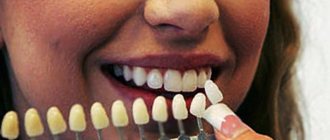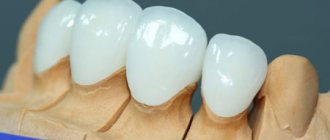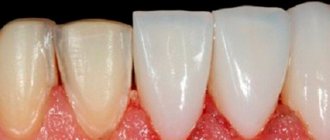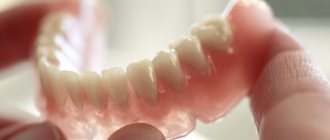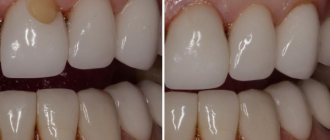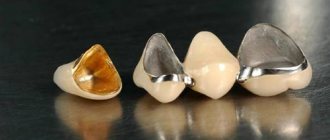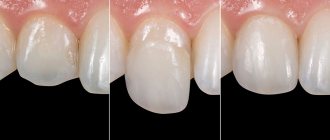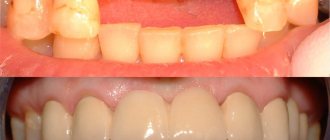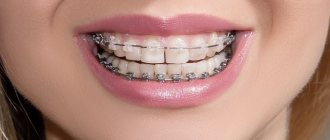What are temporary veneers, why get them and how long will you have to wear them?
Today, installing veneers that make a smile attractive is a procedure that is available to everyone. And almost a century ago, only Hollywood actors could afford them, and even then not for long - only for the period of time while filming took place. Celebrity stylists put thin plates on the teeth as a kind of make-up or disguise defects, and glued them with a temporary composition. After 1-2 days, such overlays were removed. Today, high-quality veneers that are installed in dental offices are permanent structures that serve their owners for 5-7 or more years (depending on the properties of the selected material). However, on the Internet you can find information about removable veneers. What are these structures? Find out more in our article today!
Are there any complications?
The most common complication is the appearance of caries in the deep tissues under the prosthesis. Detachment of the “onlay” from the dental walls, chipping of ceramics or composite (or even the walls around the denture with the development of cervical caries, for example), can also occur. Another possible complication is injury to the antagonist tooth (chip or periodontitis). Complications occur if the following mistakes are made:
- preliminary diagnosis was incomplete or carious tissue was poorly removed,
- the patient, while wearing a temporary filling, did not follow the recommendations of the orthopedist and chewed intensively on the prosthetic side,
- violation of technology when taking impressions, manufacturing, fitting and installation.
What are veneers
Veneers are very thin shells made of composite material, zirconium dioxide or ceramic. They are glued to the filed enamel surface with special cement in order to make the patient's front teeth ideal, i.e. hide all external cosmetic defects and imperfections: chips, cracks, unsightly shade, fillings, diastema, slight curvature.
Read more about what veneers are in a specially prepared article on the website.
This orthopedic solution has its pros and cons. For example, its advantages include high aesthetic results and low trauma during installation compared to crowns. And among the disadvantages is a fairly high price. Also, do not forget that grinding the enamel before installing veneers is still necessary, and this process is irreversible, because After removal, the teeth will no longer look the same as before.
Caring for dental veneers
If a person uses dental veneers, he should know how to care for them at home. Otherwise, the microprosthesis or decoration will quickly lose its aesthetic properties or break.
Rules for caring for dental veneers:
- After installing onlays in dentistry, you should immediately consult with your doctor about all the intricacies of oral care.
- After dental restoration, it is not advisable to eat very hard foods and viscous products, so as not to damage the lining.
- It is better not to consume foods and drinks that have aggressive and coloring properties (wine, coffee, pomegranates) or consume them in minimal quantities.
- You need to regularly brush your teeth and treat removable veneers with special solutions recommended by your dentist.
- Metal attachments and composite trims need to be polished periodically as their surfaces will scratch and dull over time.
- Several times a year you need to visit the dentist to monitor the condition of the oral cavity and the false teeth themselves, as well as professional cleaning of the products.
Fixed onlays on the chewing or front teeth, glued to dental cement, cannot be removed either at home or in the clinic. If they deteriorate or break, you need to restore the tooth using other methods, for example, placing a crown on top.
The use of false teeth helps a person correct many dental defects and brighten his smile. But the beauty of the dentition is achieved only with proper installation of structures and careful care for them. Therefore, you need to be careful when choosing a dental clinic and the materials used to make the onlays, and after installing them, you should monitor your hygiene and lifestyle.
What are removable veneers and what are they for?
These are temporary overlays or caps made of plastic that the doctor installs on the teeth after preparing the enamel and taking impressions. The fact is that permanent veneers still need to be made in a dental laboratory so that they recreate the anatomy of the patient’s natural teeth as accurately as possible and look natural. The production of onlays can take from 1 week to a month, it all depends on the workload of the laboratory. During this period of time, the ground enamel does not look very aesthetically pleasing, and without temporary overlays it will also remain defenseless against external influences: bacteria, plaque, temperature and hardness of food.
To protect the ground enamel, doctors resort to the use of removable veneers. The plates are made of plastic and attached with glue, which, however, can be easily removed in the dental office. Such onlays allow you to protect your teeth while the patient is waiting for a follow-up appointment with the orthopedist.
Quality assessment parameters
High-quality microprostheses must be produced with the highest precision and according to the individual parameters of a particular patient. Therefore, a good prosthesis can be made in 1-3 weeks, which includes not only the production itself, but also modeling, creating a blank, and trying it on to evaluate all the characteristics.
Complex on 4 OSSTEM implants with delayed loading - 140,000 rubles.
Complex implantation Osstem (South Korea) with delayed loading after 4-6 months.
Doctor's work guarantee - up to 5 years (under an agreement on the provision of medical services) Call now or order a call
Opening hours: 24 hours a day - seven days a week
Before choosing the type and material of a microprosthesis, the dentist must conduct a diagnosis. It also includes an X-ray examination to determine possible pathologies (caries, pulpitis, periodontitis, etc.). X-rays are also taken after prosthetics to assess the tightness of the fit to the walls and the absence of air cavities. By the way, during regular medical examinations the dentist can also take x-rays of the restoration - to identify the nuances and pathologies mentioned earlier.
Perfect Smile overlay veneers
By removable veneers, dentists mean temporary overlays that protect the patient’s teeth from external influences for that period of time until permanent ones are made. However, today on the Internet you can find offers from various online stores in which users are told about the advantages of inexpensive overlay veneers. For example, Perfect Smile from the USA. Manufacturers claim that this miracle product allows you to achieve an ideal snow-white smile for a while and does not require you to make any sacrifices at all, i.e. allow you to do without grinding the enamel.
But let’s look at their main advantages from the manufacturer’s point of view, and then the disadvantages from the point of view of deceived buyers who have already fallen for the tricks of marketers advertising this product and many beautiful pictures. We will also find out the opinion of professional dentists on this matter.
The manufacturer claims that such devices are universal and are suitable for absolutely all people who need to look irresistible at some event (wedding, business meeting, photo and video shooting). The essence of this method is simple: temporary products are put on the teeth like a mouthguard, and are held securely due to the chemical properties of the material.
To use these veneers, you need to heat them in boiling water for a few minutes, then remove them using a clean cutlery, let them cool slightly and place them tightly on the upper or lower teeth. This is done so that the inside of the veneers adapts to the individual structure of the dentition. After which the pad is removed and placed in a glass of cold water. After the outer side of the veneers turns snow-white, they are placed on the teeth and worn.
Important! Although temptingly cheap, such overlay plates have several significant drawbacks. For example, they do not have an individual design, they do not take into account the structure of the oral cavity, which means they may be uncomfortable to wear. Besides, they look unnatural. In addition, they have to be removed before each meal, otherwise they quickly become unusable.
It would seem that in the head of someone who is going to buy overlays, an ideal image is created. However, in reality everything turns out to be not so beautiful. Plastic or propylene products that people received by mail, after placing them in boiling water, immediately stuck to their teeth, but as soon as they cooled down, they instantly fell off, i.e. They don't stay in the mouth at all. Users also note that they have an unpleasant taste and smell of plastic, like any cheap Chinese product. Plus, the onlays did not fit the size of the teeth, because, of course, they are templates, and at the same time they are not made in a jewelry manner.
Dentists and orthopedists are of the same opinion: if you want to solve dental problems, go to a professional doctor, and do not buy masquerade toys that have a dubious composition. Not only will they not make your smile attractive, but they can also negatively affect your health, because no one rules out the toxicity of the material from which these products are made. In addition, you need to use common sense and understand that pads that are fixed to the water are nonsense.
Indications for installation
All the solutions listed above are not alternatives to each other. With some exceptions, you cannot choose the option that you simply like best. Each of them is designed to solve specific problems and is used in certain cases. Indications may be as follows:
- Unsightly enamel color that cannot be removed with bleaching. For example, this may be yellowing due to smoking and taking certain medications, or white spots due to fluorosis.
- Enamel defects: chips, cracks. They not only make teeth and smile unsightly, but also increase their sensitivity, and this causes discomfort when eating, cold and hot drinks. By the way, small defects are sometimes covered with skys.
- Large spaces between teeth (threes). They can be corrected with braces. But not all people are ready to wear them. Overlays are much faster, they allow you to immediately get an excellent cosmetic effect.
- Crooked teeth. One of the options to correct this problem is to use overlay dentures. However, they have limited use when the deviations are small and do not affect the bite.
- Fillings that look ugly. Modern technologies allow you to choose the color of the filling material, like tooth enamel. But what to do if you had a filling a long time ago, it stands out a lot, spoils your appearance, you are embarrassed to smile because of it, and whitening does not help? In such cases, it is worth considering the option of veneers.
How removable veneers are made and applied
Since the installation of temporary plates is one of the stages of prosthetics, they are made on the basis of the same impression that is made for turning permanent dentures. This allows you to create a product based on an individual layout, as well as correct shortcomings that are revealed during the installation of temporary veneers.
On a note! Sometimes on the Internet you can find information that composite veneers are called removable, which the doctor can install on the teeth in just one visit through layer-by-layer application of the composite, and, if necessary, also quickly remove or make corrections. However, in relation to composite onlays, terms such as “removable” or “temporary” cannot be used, because With careful care they can last 3-5 years.
To attach the plates, the doctor uses special cement, which will provide strong adhesion and protection from thermal effects, but can be easily removed from the tooth by the dentist.
Differences in purpose - stump and restorative
The topic of today's article is developing around microprosthetic inlays; they are needed to restore a natural crown and are therefore called “restorative”. Restorative ones are attached to the outside of the tooth and are visible to anyone if they open their mouth. In fact, they are alternatives to fillings.
What is an inlay for a tooth under a crown? There is another option for permanent prosthetics - this is the stump type. It is needed not for beauty, but for strength. Stumps, as the name implies, have the shape of a tooth stump. The lower part of the stump tab is inserted into the root canals, and the upper part rises slightly above the gum and serves as a support for the crown or prosthesis. Those. the stump will not be visible, no matter how you open your mouth, because it is always hidden by an artificial crown. But, in fact, it is also restorative, but it replaces not only the apex, but also the dental canals. You can read more about this type in a separate article.
Stages of plastering models into an articulator
We continue diagnostics and conduct instrumental functional analysis. We install the models in anatomical relation to the skull and joint.
The upper jaw is transferred to the articulator along the kinematic arc of the condylograph. The lower jaw is plastered to the upper jaw in a centric relation.
Ceramic tooth inlay: pros and cons
- Good functionality. The inlay not only accurately copies the shape of the tooth, but also allows you to completely restore chewing function
- Great aesthetics. Ceramics is the best material for aesthetic prosthetics
- Safety. Ceramics is a bioinert material that does not cause allergies.
- Ceramic inlays do not stain or fade over time
- Long service life. If you choose a dental inlay instead of a filling, you can expect it to last at least 10 years
- May not be used in all cases (see contraindications)
- Fairly high price
- Sometimes installing a crown will be a more reliable solution in the future
Verticalization (raising the bite)
We carry out virtual modeling of bite elevation (VTO) in the Gamma program at 5 mm (meaning the incisal pin of the articulator). The initial bite height was 38.4 (values obtained when calculating the lateral TRG). After raising the bite we get a value of 40.8, which shows us that we are working in the adaptation zone (green area), and this is acceptable for this patient

